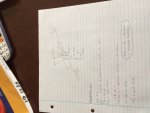‘A block B is placed on a plane inclined at 30 degrees tothe horizontal. A particle P of mass 0.65kg is placed on the upper surface ofB…It is given that B is in equilibrium while P moves on its upper surface’
iii) Given that the weight of B is 7N, calculate the set ofpossible values of coefficient of friction between B and the plane (7).
*My actual questionis why you don’t include the weight component of P (see diagram)
I understand the rest of the question bar this bit. Thanksin advance for any responses
NB if values appear it’s because there’s a part I and iiwhich I’ve completed.
iii) Given that the weight of B is 7N, calculate the set ofpossible values of coefficient of friction between B and the plane (7).
*My actual questionis why you don’t include the weight component of P (see diagram)
I understand the rest of the question bar this bit. Thanksin advance for any responses
NB if values appear it’s because there’s a part I and iiwhich I’ve completed.

